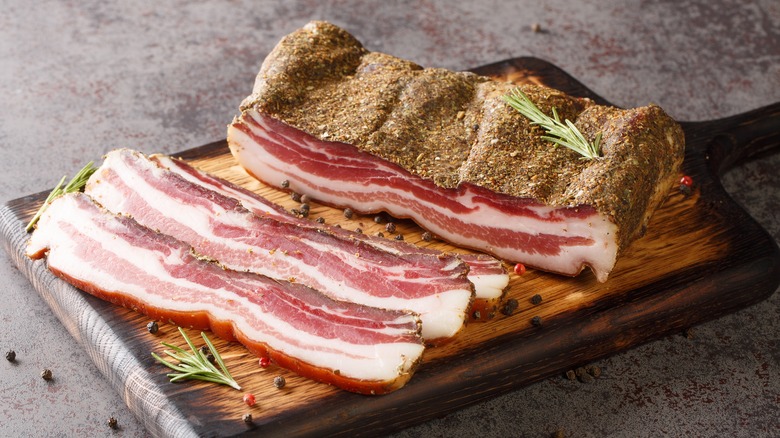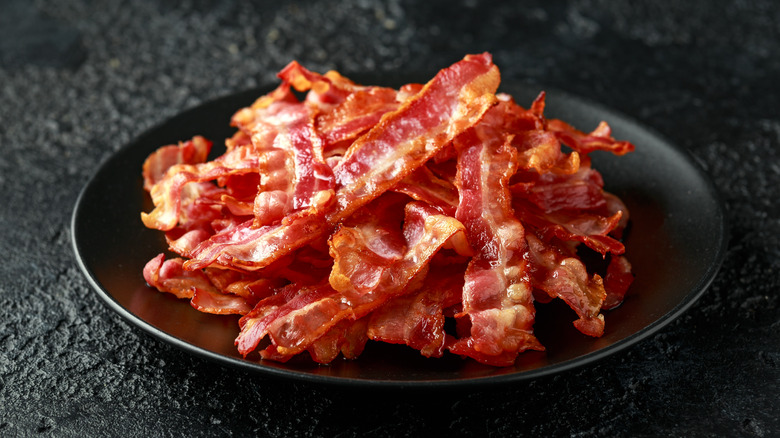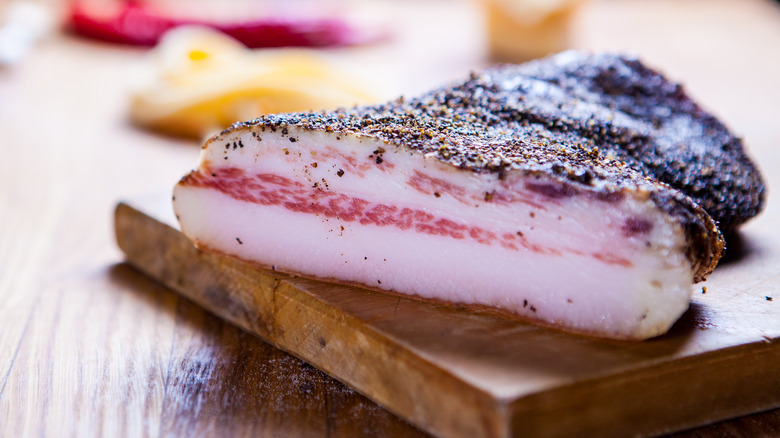Here's What Makes Guanciale Different From Bacon
The world of preserved meat would be diverse and wondrous, even if bacon and guanciale didn't exist. Ranging from cheap and tasty beef jerky to a $4,500 Jamón Ibérico, the art of drying meat has produced a cornucopia of pork and beef products that could take a lifetime to explore (via Insider). According to Volpi, cured and preserved meats run the gamut of styles dependent on not just the cut of meat, but also the preservation method and time spent aging. Those variables are how you get things as different as fatty, crispy bacon, and soft, spreadable liverwurst.
Any category of food that produces that kind of diversity is also bound to produce some overlap. It's tough enough remembering what's salumi and what's salami, but when you start getting into something as various as the many types of prosciutto, things can get murky. The differences matter, though, because when you're cooking, what seems like a subtle variation could end up having a big impact on the dish. This is especially important for bacon, which Kitchn notes often gets substituted for other less common meats like pancetta. Guanciale is another preserved pork product you may have stumbled on in a recipe where bacon is suggested as a substitute, or vice-versa. But how similar are they?
What is bacon?
Bacon is so popular, and used in so many products, that it has almost taken on a generic feel. In reality, bacon is a very specific cut and style of preserved meat. According to MasterClass, what we know as bacon in America is salt-cured slices of pork belly. There are other types of bacon in the world, like back bacon, known in the U.S. as Canadian bacon, but anything else called bacon in the U.S. will be salty, fatty, have a smoky flavor, and will shrink and crisp up when cooked. Outside the U.S., American-style bacon is also known as "streaky bacon," after the unique look it gets from the thin slices of fat-streaked pork belly meat.
Bacon can be cured and uncured, but uncured bacon is preserved using only natural ingredients like salt, while cured bacon uses preservatives like nitrates and nitrites. Another thing that sets bacon apart is that it is usually smoked, which is why you often see flavors like hickory or applewood on package labels. While traditional bacon would use actual smoking techniques, bacon purveyor, S. Clyde Weaver notes that modern factory bacon often has the smoke flavor added by injecting the meat with liquid smoke. You can find classic smoked bacon by looking for the label "hardwood smoked," or "naturally smoked."
What is guanciale?
Guanciale may not be as familiar to you as bacon, but it's a popular ingredient in Italian dishes like pasta alla gricia. According to La Cucina Italiana, the cut of pork guanciale comes from the cheek or jowl, not pork belly like bacon or its Italian variety pancetta. It is aged for three months after being rubbed with salt and spices, which gives it a robust and distinctive flavor compared to bacon or pancetta. It is also quite fatty, with a noticeably tougher texture. While bacon is often eaten whole and on its own, guanciale is particularly prized as a source of cooking fat for sauces like amatriciana.
While guanciale can sometimes be substituted for bacon, it has some pretty different characteristics that should be considered, and might not be the best option in certain dishes. Allrecipes states that guanciale is much saltier, which means it can be less pleasant to eat on its own and will add a lot more saltiness to any dish it's used in. Guanciale is also not smoked like bacon; instead, its flavor comes from the aging process and the added spices. It will still bring the rich, salty, meaty flavor bacon does, but the curing process gives it a stronger, more distinct flavor. While they do share some traits, guanciale is best appreciated as its own unique ingredient, starring in classic Italian dishes like pasta carbonara, where its sweet, slightly funky flavor and rich rendered fat can really shine.


